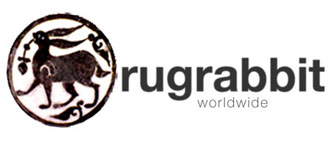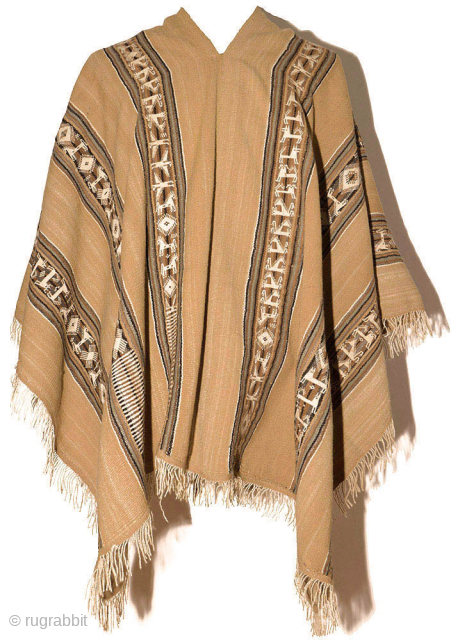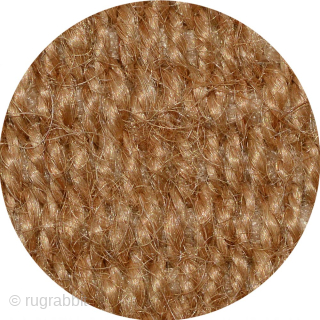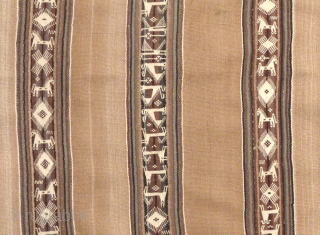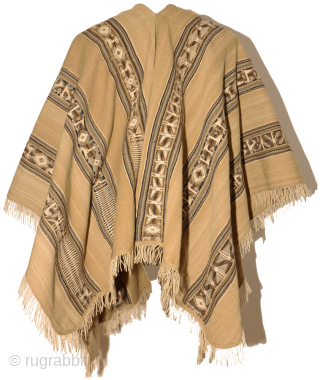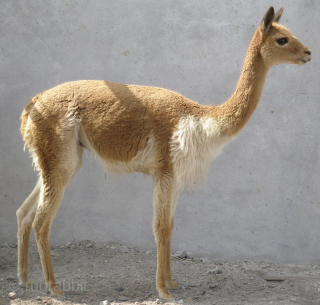Back
Featured Posted Today
An exemplary ceremonial poncho from the Charazani village area, Department of La Paz, Bolivia, South America. The tan camelid fibre used in this piece comes from the Vicuna, a relative of the high mountain alpaca, and is hand spun and undyed, which when the fleece from various animals is selectively combined in the weaving process – as is the case here - produces a beautiful natural abrash. Finely woven - the ‘enclosed’ square above is 1 square inch or approximately 2.5cm x 2.5cm. The circle has a diameter of approximately 1cm or about 2/5 of an inch - in two panels using the age-old ancestral technique on a horizontal staked loom and then stitched together along the centre line, the size is 152cm x 127cm plus a 4-5cm fringe (approx. 60in x 50in x 2in). The six rows of designs feature diverse zoomorphic figures with geometric designs interspersed among them, with the darker stripes being Alpaca fibre and the white threads cotton. It also features special 'lloque' (pronounced 'yo-kay') weaving in the stripes, a term which denotes reverse spun yarns that are not commonly used and are believed to contain magical properties which are imbued to the textile. Prior to having been bought in Bolivia during the 1970’s by its previous owner, it had been a family heritage item intended to be kept as an heirloom piece and its excellent preservation is due to the fact that is was used only sparingly at religious ceremonies or on very special festive occasions, hence its near perfect condition with no repairs or reweaves (and it has professionally cleaned since being collected). a one of a kind museum quality piece in exemplary condition makes this a deserving collectors item. Please see many more photos and information here https://warpandweft.club/portfolio-item/south-america-6/; and more South American pieces here https://warpandweft.club/portfolio-item/south-america/
price:
POR. wandw@nym.hush.com
- Home
- Antique Rugs by Region
- Category
- Profiles
- Post Items Free
- Albums
- Benaki Museum of Islamic Art
- Budapest: Ottoman Carpets
- Gulbenkian Museum
- Islamic Carpets. Brooklyn
- Islamic Textiles. Brooklyn
- Konya Museum: Rugs
- MKG, Hamburg
- MMA: Caucasian Carpets
- MMA: Mamluk Carpets
- MMA: Mughal Indian Carpets
- MMA: Ottoman Carpets
- MMA: Safavid Persian Carpets
- MMA: Turkmen Rugs
- McCoy Jones Kilims
- Ottoman textiles. Met
- Philadelphia Museum
- Rugs and Carpets: Berlin
- Seljuqs at the Met
- TIEM, Istanbul: Carpets
- V&A: Classical Carpets
- Vakiflar Carpets: Istanbul
- Baluch Rugs: Indianapolis
- Gallery Exhibitions
- Jaf an Exhibition
- Alberto Levi Gallery
- Andean Textile
- Christie's London: 2016
- Francesca Galloway
- HALI at 40
- ICOC Washington, DC 2018
- Jajims of the Shahsavan
- London Islamic Week April, 2018
- Mongolian Felts
- Navajo Rugs: JB Moore
- Persian Piled Weavings
- SF Tribal & Textile Art Show 2020
- SF Tribal 2019
- Sotheby's: C. Alexander
- Turkish Prayer Rugs
- Turkmen Main Carpets ICOC 2007
